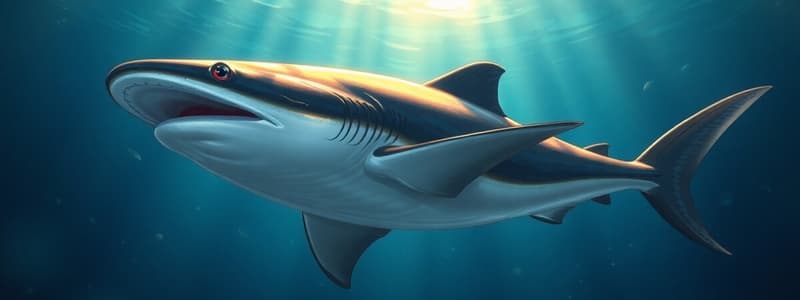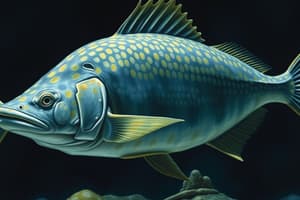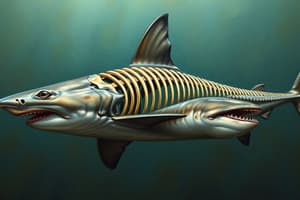Podcast
Questions and Answers
What is the primary component of the skeleton in Chondrichthyans?
What is the primary component of the skeleton in Chondrichthyans?
- Cartilage (correct)
- Bone
- Calcium Carbonate
- Keratin
The cartilaginous skeleton of Chondrichthyans evolved in what way?
The cartilaginous skeleton of Chondrichthyans evolved in what way?
- Independently, unrelated to bone development.
- Simultaneously with bony fish skeletons.
- Secondarily from a mineralized skeleton. (correct)
- Directly as the primary skeletal structure.
Which group represents the largest and most diverse within the Chondrichthyan class?
Which group represents the largest and most diverse within the Chondrichthyan class?
- Elasmobranchii (sharks, rays, skates) (correct)
- Actinistia (coelacanths)
- Holocephali (chimaeras)
- Dipnoi (lungfishes)
What evolutionary advantage might a cartilaginous skeleton provide to sharks compared to a bony skeleton?
What evolutionary advantage might a cartilaginous skeleton provide to sharks compared to a bony skeleton?
If a fossil of an ancient fish displays both cartilage and bone tissues, what could this indicate about its evolutionary position?
If a fossil of an ancient fish displays both cartilage and bone tissues, what could this indicate about its evolutionary position?
Which characteristic distinguishes Chondrichthyans from Osteichthyes (bony fish)?
Which characteristic distinguishes Chondrichthyans from Osteichthyes (bony fish)?
How does the density of cartilage compared to bone affect swimming energetics in sharks?
How does the density of cartilage compared to bone affect swimming energetics in sharks?
If a scientist discovers a new species of Chondrichthyan, what skeletal feature would they expect to observe?
If a scientist discovers a new species of Chondrichthyan, what skeletal feature would they expect to observe?
What can be inferred about the lifestyle of early Chondrichthyans based on the transition from a mineralized skeleton to a cartilaginous one?
What can be inferred about the lifestyle of early Chondrichthyans based on the transition from a mineralized skeleton to a cartilaginous one?
Suppose a marine biologist is studying the phylogeny of fish. How would the skeletal composition of Chondrichthyans inform their phylogenetic analysis?
Suppose a marine biologist is studying the phylogeny of fish. How would the skeletal composition of Chondrichthyans inform their phylogenetic analysis?
How does the presence of a cartilaginous skeleton potentially impact the fossilization process of Chondrichthyans compared to bony fish?
How does the presence of a cartilaginous skeleton potentially impact the fossilization process of Chondrichthyans compared to bony fish?
If a gene responsible for bone mineralization is artificially activated in a developing shark embryo, what would be the most likely outcome?
If a gene responsible for bone mineralization is artificially activated in a developing shark embryo, what would be the most likely outcome?
Considering the evolutionary history of Chondrichthyans, what is the significance of their continued reliance on cartilage?
Considering the evolutionary history of Chondrichthyans, what is the significance of their continued reliance on cartilage?
How might the skeletal structure of sharks influence their ability to recover from injuries, compared to bony fish?
How might the skeletal structure of sharks influence their ability to recover from injuries, compared to bony fish?
If a ray's cartilaginous skeleton were to become heavily mineralized due to a genetic mutation, what could be the potential consequences?
If a ray's cartilaginous skeleton were to become heavily mineralized due to a genetic mutation, what could be the potential consequences?
What role could the cartilaginous skeleton play in the electroreception abilities observed in sharks and rays?
What role could the cartilaginous skeleton play in the electroreception abilities observed in sharks and rays?
Considering the ecological niches occupied by sharks, rays, and skates, how does having a cartilaginous skeleton support their survival in diverse marine environments?
Considering the ecological niches occupied by sharks, rays, and skates, how does having a cartilaginous skeleton support their survival in diverse marine environments?
In the context of evolutionary trade-offs, what is a potential disadvantage of having a cartilaginous skeleton compared to a bony skeleton?
In the context of evolutionary trade-offs, what is a potential disadvantage of having a cartilaginous skeleton compared to a bony skeleton?
If a drug was developed to inhibit cartilage formation in fish, which group would be most directly affected?
If a drug was developed to inhibit cartilage formation in fish, which group would be most directly affected?
Flashcards
Chondrichthyans
Chondrichthyans
A class of jawed fish with skeletons primarily made of cartilage.
Cartilaginous Skeleton Origin
Cartilaginous Skeleton Origin
In Chondrichthyans, the skeleton evolved from a mineralized form.
Largest Chondrichthyan Group
Largest Chondrichthyan Group
Includes sharks, rays and skates.
Study Notes
- Chondrichthyans' skeletons are mainly cartilage.
- Cartilaginous skeletons in this group evolved from mineralized ancestral ones.
- Sharks, rays and skates make up the biggest, most varied chondrichthyan group.
Studying That Suits You
Use AI to generate personalized quizzes and flashcards to suit your learning preferences.



